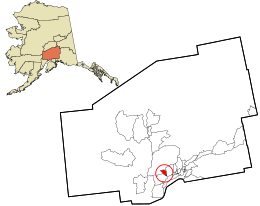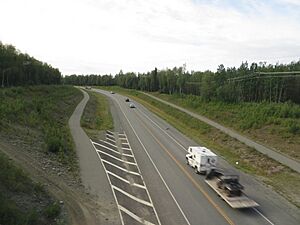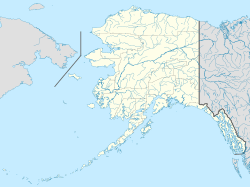Houston, Alaska facts for kids
Quick facts for kids
Houston
|
||
|---|---|---|
|
||

Location in Matanuska-Susitna Borough and the state of Alaska
|
||
| Country | United States | |
| State | Alaska | |
| Borough | Matanuska-Susitna | |
| Incorporated | June 6, 1966 | |
| Area | ||
| • Total | 25.26 sq mi (65.41 km2) | |
| • Land | 23.94 sq mi (62.01 km2) | |
| • Water | 1.32 sq mi (3.41 km2) | |
| Elevation | 249 ft (76 m) | |
| Population
(2020)
|
||
| • Total | 1,975 | |
| • Estimate
(2022)
|
2,100 | |
| • Density | 82.50/sq mi (31.85/km2) | |
| Time zone | UTC-9 (Alaska (AKST)) | |
| • Summer (DST) | UTC-8 (AKDT) | |
| ZIP code |
99694
|
|
| Area code | 907 | |
| FIPS code | 02-33800 | |
| GNIS feature ID | 1416613 | |
| Website | www.houstonak.us | |
Houston is a city in Alaska, located in the Matanuska-Susitna Borough. It's considered part of the larger Anchorage area. Even though it's about 33 miles from downtown Anchorage, the drive is longer, around 57 miles. In 2020, about 1,975 people lived there.
Contents
Where is Houston, Alaska?

Houston is found along the George Parks Highway and the Little Susitna River. It covers a total area of about 23.9 square miles (62 square kilometers). Most of this area is land, with a smaller part being water.
Who Lives in Houston?
| Historical population | |||
|---|---|---|---|
| Census | Pop. | %± | |
| 1970 | 69 | — | |
| 1980 | 370 | 436.2% | |
| 1990 | 697 | 88.4% | |
| 2000 | 1,202 | 72.5% | |
| 2010 | 1,912 | 59.1% | |
| 2020 | 1,975 | 3.3% | |
| U.S. Decennial Census | |||
In 2020, there were 1,975 people living in Houston, making up 726 households. The population density was about 82.5 people per square mile.
Diversity in Houston
Most people in Houston are White (80.4%). Other groups include Black or African American (1.4%), Native American or Alaska Native (4.0%), and Asian (1.1%). About 9.1% of residents are from two or more races. Around 4% of the population is Hispanic or Latino.
Age and Families
About 20.3% of the people living in Houston are under 18 years old. Around 15% are over 65 years old. The average age in Houston is 43.3 years. There are more men than women in the city.
Many households are families (411 out of 726). About 145 family households include children under 18.
Income and Veterans
The average income for a household in Houston was $53,750. For families, it was $75,096. About 20% of the population lives below the poverty line. This includes 33.3% of those under 18 and 10.1% of those 65 or older.
Many Houston residents have served in the military. About 14% of residents are veterans. This is higher than the average for Alaska and the United States.
History of Houston
Houston Siding first appeared on a map of the Alaska Railroad in 1917. It was important for mining operations in the area. During World War II, the U.S. Navy used it a lot. After the war, the mines were closed.
Houston officially became a city in 1966.
Important Events
- On August 30, 1972, George Boney, who was the chief justice of the Alaska Supreme Court, died in a boating accident in Houston.
- On June 3, 1996, a large wildfire called the Miller's Reach Fire burned over 37,000 acres (15,000 hectares) in Houston and nearby Big Lake. It destroyed 454 buildings and cost over $16 million.
Fireworks in Houston
Houston, Alaska, is known for its legal fireworks sales. The Gorilla Fireworks Stand along the Parks Highway sells many types of fireworks. These fireworks are not allowed in most of the Mat-Su Borough and Anchorage.
The money from fireworks sales helps pay for emergency services in Houston. These stands are the only place in Southcentral Alaska where you can legally buy fireworks. The taxes from these sales cover 10-15% of the city fire department's budget.
Fireworks Tax
People who buy fireworks pay a 2% sales tax, plus an extra 2% tax. Houston voters approved this policy in 2010. The extra tax helps "promote increased public safety," and all of this money goes to the fire department.
Notable Person from Houston
- James Bondsteel (1947–1987) was a Medal of Honor recipient who lived in Houston until his death.
See also
 In Spanish: Houston (Alaska) para niños
In Spanish: Houston (Alaska) para niños



